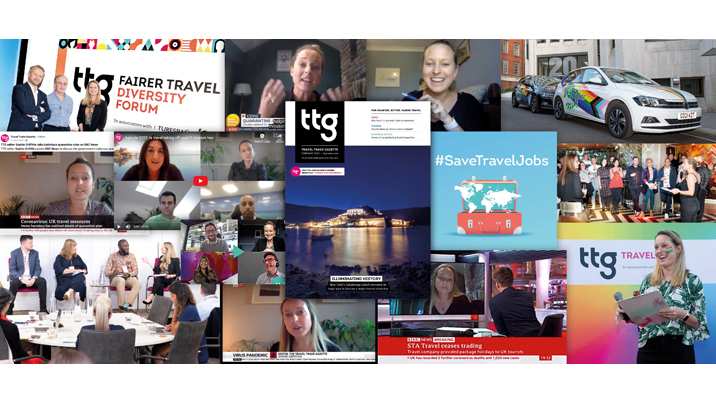
With ‘purpose’ high on the corporate agenda, interest in walking the talk and the backlash when you don’t have never been greater. But at travel industry title TTG, purpose is more than just on trend. Baked into the brand’s DNA, it’s what gets the team out of bed each morning.
And, according to its editor, Sophie Griffiths, who recently took on the additional role of TTG’s chief purpose officer (CPO), its purpose – boldly defined as working to build a smarter, better, fairer travel industry – is key to the brand’s future.
“We are a purpose-driven business,” she says. “And in our market, the fact we are really helps us stand out.”
Griffiths – TTG’s editor since 2017 and CPO since January, who was named Editor of the Year at the recent PPA Independent Publisher Awards – may now have two titles but her joint roles are inextricably entwined.
As editor, her focus is to drive standards higher throughout TTG content, which ranges from the perfect-bound in-depth monthly and its news-focused website to a rapidly growing array of campaigns and events including awards, live briefings, conferences and themed weeks.
Mission
As CPO, her mission is to raise standards around sustainability and diversity and inclusion within TTG’s own business and across the industry it serves by leveraging said breadth of content.

“We have two goals as a title: to be the most trusted and most well-read respected travel trade title in the UK and Ireland, and to continue in our drive to press for a smarter, better, fairer travel industry – which is our whole purpose as a business,” she explains.
‘Smarter’ is a promise to give travel professionals the tools, the knowledge and the contacts they need to improve their personal performance. ‘Better’ is a promise to drive up best practice and standards across the travel industry, including the media. ‘Fairer’, meanwhile, is about championing responsible tourism – both by people who travel and by the people in the travel industry.
“It’s about making sure we are standing out on the content side and, at the same time, in terms of our values and principles,” she says.
TTG, launched as Travel Trade Gazette in 1953, is the world’s oldest travel trade newspaper.
A weekly until 2021 when the title went monthly – a move that enabled a clearer differentiation between the role and purpose of the print and digital products, Griffiths says – the print magazine now carries in-depth analysis while the website is dedicated to breaking news.
Quality content
“On the editorial side, the constant emphasis is on driving standards higher. And this means thinking differently about the content we produce,” Griffiths explains. So, in response to the travel industry’s plethora of free news sites, TTG has become more selective about the news it does carry.
“This means looking at unique angles and digging deeper to explore what news stories really mean for TTG readers. Recently, for example, we’ve played around with TTG’s newsletter strategy,” she says.
“Rather than simply have two daily latest news updates, we’ve introduced a 4pm must-read story of the day that’s either something we know has not been picked up elsewhere or our own unique angle.”
Also evolving is TTG+, TTG’s paid content proposition, launched in September 2020, which has been through a number of iterations.
“Initially, we charged readers for news. But we realised this wasn't going to work in our marketplace where there are other news sites offering news free. So instead, we switched our focus to offering exclusive member benefits,” Griffiths continues.
Benefits range from Travel Agent Tracker reports – state of the marketplace snapshots based on TTG’s rolling reader research, and live monthly briefing calls she hosts with TTG news editor James Chapple – to exclusive seminars, events and archive access.
“We’ve partnered with PwC and hosted a series of sustainability and diversity and inclusion (D&I) seminars. And we produce insight reports every quarter – exclusive insights into what consumers and CEOs are saying about travel, then host an afternoon seminar on this for members,” she adds.
“Our registration wall was introduced in 2018 and we’re continuing with this as we’re now the only travel trade media to know who is reading our content. This provides us with a whole raft of helpful data as we continue to evolve our content strategy.
“We’ve lots of (TTG+) members – we’ve just had a really strong wave of renewals – and we’re just working out what the next steps will be.”
Griffiths took over as editor two years after she launched TTG LGBT – an initiative to champion greater diversity in the travel industry through networking and education, from which evolved the brand’s smarter, better, fairer mission with its two key pillars: sustainability and D&I.
“Having come up from the news side, my initial approach (as editor) was very much focused on the magazine and website and ensuring the content was as strong as it could be and closely aligned with TTG’s purpose,” she says.
The Covid effect
“But through Covid, my approach evolved considerably.”
Managing the quantum shifts of putting a magazine to press remotely, getting to grips with working from home and supporting team members through an incredibly challenging time was only the start of it.
As important, she soon realised, was supporting readers – many of whom already worked from home, felt incredibly isolated, and feared for their livelihoods in the industry perhaps worst hit by the pandemic – by listening, community-building, educating, informing and sharing support and advice.
“In our industry, where others perhaps took a step back or paused, we actively went the other way,” Griffiths says. “We ploughed all our efforts into fighting to get travel onto the government’s agenda – and impressing upon them the sector’s real and horrible plight.”
By doing so, TTG got closer than ever before to its readers – as has been the case for many B2B brands. And now the worst effects of the pandemic have receded, she and her team have redoubled efforts around their mission to take maximum advantage of this.
Recent initiatives include countless forums, seminars and talks, a Travel Pride celebration and awards scheme called Travel Pride Champions, and Fairer Travel Week which TTG launched last year and brings back this July.
D&I
“I’m proud of how TTG has helped put D&I on the travel industry’s agenda. Back in 2015, there was some eye-rolling and some accused us of creating divisions. It took time. But now companies are coming to us for advice,” she says.
Griffiths is also proud this commitment carries through to asking difficult questions – of others and of itself.
“Last November, when the FIFA World Cup was taking place, we came out with a big piece asking should the travel industry support destinations like Qatar. This raised eyebrows but also attracted praise,” she says.
“We also turned down advertising for things that don’t align with our values – for instance, Saudi. At a time when everyone was under extreme pressure, that was a bold statement. It made us as a team hold our heads up high.”
Closer to home, TTG has overhauled its editorial guidelines to improve D&I in its content.
“Travel is notorious for having travel brochures filled with 2.4 white straight families on holiday and that’s just not representative of modern Britain,” she continues.
“But we are much better now with our imagery. If we write a piece about honeymoons or weddings, we won’t just cover straight couples. And we won’t just put gay couples in an LGBT feature, either.
“We’re doing more about accessible travel, too, and we have a dedicated accessible travel seminar for the first time this year which we are very excited about. We are always looking at ways we can do more.”
Sustainability
On the sustainability side, meanwhile, TTG signed up to the Glasgow Declaration and is now on a journey to measure its own carbon footprint, which it is already working to actively reduce.
“Every event we put on, we are asking questions of ourselves, our partners, our suppliers and our visitors that we’d never have asked before. Sustainability is now fundamental to our publishing strategy so it has to flow through everything that we do,” says Griffiths.
“All of us are on a journey and it’s all about education – everyone has so much still to learn. There’s a long way to go but we are doing everything we can.”
The appointment of Griffiths as chief purpose officer is a further endorsement of the importance to the business of all this.
“It firmly establishes and shows everyone how seriously we take our values as a business. And the fact it came from the CEO was important, too, as real change only really happens when it is driven from the top,” she says.
So, should every publisher now have a chief purpose officer?
“Yes. But it’s a role that should come from the top. And a company should only have that position if it is incredibly serious about those values and is prepared to put its money where its mouth is,” Griffiths cautions.
When it comes to how far the publishing sector has come in relation to D&I, Griffiths is equally measured.
“Some of the big publishing houses are making the right noises, and the PPA is doing a really good job,” she observes, pointing out she sits on the PPA’s D&I steering committee.
“But in terms of individual companies, I think everyone has a responsibility to do a lot, lot more – particularly when it comes to apprenticeships and working with schools to try and get more children from a greater diversity of backgrounds to consider journalism.
“Social mobility is a really big issue.”
Another mission beckons.
This article was first published in InPublishing magazine. If you would like to be added to the free mailing list to receive the magazine, please register here.












